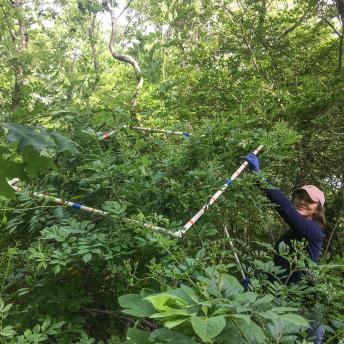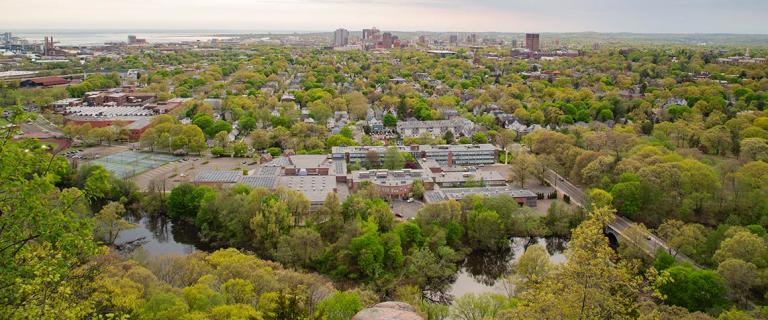
Danica Doroski ’21 PhD examines forest dynamics and regeneration patterns in New Haven's urban forest patches.

Forests within cities are becoming increasingly important as urban areas continue to expand because they provide a range of social, ecological, economic, and health benefits. A new study, co-authored by researchers from The Forest School at YSE, examines how New Haven’s urban forest patches change over time and how the findings can contribute to effective management strategies.
More than two-thirds of the world’s population are predicted to reside in cities by 2050, with urban areas expected to increase by 40%. Forests within urban regions provide a range of social, ecological, economic, and health benefits, but how urban forests change over time and regenerate is not well understood. A new study led by The Forest School at the Yale School of the Environment has taken steps to address this by examining 126 forest plots in New Haven.

Danica Doroski ’21 PhD examines forest dynamics and regeneration patterns in New Haven's urban forest patches.
Danica Doroski ’21 PhD examines forest dynamics and regeneration patterns in New Haven's urban forest patches.
The study, published in Ecosphere, focused on understanding the range of conditions that can be found in urban forest patches and included all publicly accessible forest plots within the city, from small vacant lots to large intact forested parcels.
Danica Doroski ’21 PhD, lead author of the study, says she became interested in examining New Haven’s urban forest dynamics and regeneration patterns after working in New York City to restore degraded forest patches. Much of the research on urban forests has been done in big cities, leaving smaller cities such as New Haven, which are more representative of urban areas in the U.S., understudied, the researchers say. Additionally, previous research has focused on comparing urban forests to rural forests rather than examining the full range of forest conditions that can exist within just one city. Much attention has also been centered on tree plantings in urban areas as a tool to mitigate climate change.
“Tree planting is often seen as a panacea to climate change and urbanization, but planting trees is not the only solution. In urban forested patches, trees are naturally regenerating and replacing themselves already — we just need to know how to manage them better so that we can more effectively leverage these forest patches as a form of green infrastructure in our cities.
“In terms of carbon storage, forest patches are a much more effective carbon sink than planted street trees, which need to be grown in nurseries, transported, planted, and eventually removed and landfilled when they die.” Doroski says.
I am working to draw attention to these overlooked green spaces, promote more management of them, and channel resources into their long-term care and maintenance.”
The study found that some of the larger forest patches were almost identical to forests in rural settings and smaller patches in highly developed areas still had regeneration from bird-and-mammal dispersed tree species, illustrating their importance from a wildlife perspective. Even forests with non-native species could transition over time with proper management, underscoring the importance of investing in these forests and tailoring management to their unique conditions, the study found.
“What this research really shows us is that even in a relatively small city like New Haven, you can see lots of different forest types ranging from forests that are primarily dominated by native species to those that are primarily non-native dominated. Knowing that there is this diversity in urban forest types helps us to tailor our management approaches to improve outcomes and ensure healthy and sustainable future forests,” says Doroski, who is now state urban forester for the Connecticut Department of Energy and Environmental Protection. “In my current role, I am working to draw attention to these overlooked green spaces, promote more management of them, and channel resources into their long-term care and maintenance.”
The study was co-authored by Mark Ashton, senior associate dean of The Forest School at YSE, director of Yale Forests and Morris K. Jesup Professor of Silviculture and Forest Ecology; Marlyse Duguid, Yale Forests director of research; Mark Bradford, professor of soils and ecosystem ecology; Clara Pregitzer, ’20 PhD, who is deputy director of conservation science at the Natural Areas Conservancy; and Richard Hallett, a research ecologist for the USDA Forest Service.
Duguid notes that the work is unique in that it brings basic forest dynamics theory to the study of urban forests rather than applied research.
“There’s huge potential here on how we think about managing natural urban forest patches and their connectivity to the landscapes and plant and wildlife communities,” Duguid says.
Ashton says the study and Doroski’s work pushes the frontier of research on representative urban forests in the eastern U.S.
“The importance of this work shows that urban forestry is not a niche, separate from rural or peri-urban forests. They are intimately linked. Danica brings a set of information that makes us think about what we do in terms of restoration and passive versus active management,” Ashton says.
Photo: A view of New Haven, CT. Credit: Matthew Garrett